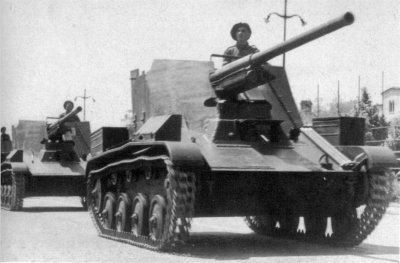Type Tank Destroyer In service 1943—45 | Place of origin Romania Used by Romania Designer Leonida | |
 | ||
The TACAM T-60 (Tun Anticar pe Afet Mobil - Self-propelled Anti-tank Gun) was a Romanian tank destroyer used during World War II. It was built by removing the turret of captured T-60 light tanks and building a pedestal to mount an ex-Soviet 76.2 mm (3.00 in) M-1936 F-22 field gun in its place. A three-sided fighting compartment was built to protect the gun and its crew. Thirty-four were built in 1943, and they served in the Jassy-Kishniev Offensive, and the Budapest Offensive.
Contents
Development
By December 1942 it was blatantly obvious that Romania had nothing capable of defeating the modern Soviet medium and heavy tanks and wasn't likely to get anything capable of doing so from the Germans anytime soon. Romania had a number of captured modern Soviet tanks and field guns and it was decided to convert them to tank destroyers on the model of the German Marder II. The T-60 light tank was chosen because Romanian industry could maintain it, not least because its engine was a license-built Dodge-Derotto-Fargo F.H.2 for which spares were available in both Romania and Germany. A captured Soviet 76.2 millimetres (3.00 in) M-1936 F-22 field gun was removed from its carriage and a new mount was fabricated to fit the gun to a turretless T-60. A fighting compartment was built using armor salvaged from captured Soviet tanks and the suspension was reinforced to handle its greater weight. Leonida finished the prototype on 19 January 1943.
Description
The TACAM T-60 had a M-1936 F-22 field gun mounted on a T-60 light tank chassis. The gun was removed from its carriage and mounted on a new pedestal that mated to the chassis. The gun-laying mechanism was modified to suit Romanian practices and a recoil guard was added to protect the gunner. The gun was protected by a three-sided, fixed gun shield with sides 15 millimetres (0.59 in) thick. The armor plate for the gun shield was salvaged from captured Soviet BT-7 cavalry tanks. The gun could traverse 32°, elevate 8° and depress 5°. A total of forty-four rounds were carried for the main gun. The chassis was modified for its new role; a new engine cover was made to improve engine cooling and the interior was modified to add more ammunition storage. The extra weight of the gun required that the suspension be modified with stronger torsion bars and new road wheels. A brake to lock the wheels while firing was also added. The armor of the hull ranged from 15 to 35 millimetres (0.59 to 1.38 in) thick. It could cross a ditch 1.3 metres (4.3 ft) wide, climb an obstacle .5 metres (1.6 ft) high and ford a stream .6 metres (2.0 ft) deep.
Operational history
A total of thirty-four were converted by Leonida in Bucharest by the end of 1943. Sixteen were assigned to the 61st Tacam Company which was assigned to the 1st Armored Regiment and eighteen were organized into the 62nd Tacam Company and assigned to the 2nd Armored Regiment. Despite these nominal assignments the TACAM T-60s were assigned as needed. The ad hoc Cantemir Armored Group was formed on 24 February 1944 to reinforce the defenses of Northern Transnistria from elements of the 1st Armored Division and included fourteen TACAM T-60s in two batteries. This was later returned to its parent 1st Armored Division and the tank destroyers fought with the division during the Soviet Jassy-Kishniev Offensive.
Nothing is known about any action immediately after Romania's defection to the Allies in late August 1944 or in the defense of Romania during the following month, but it seems likely that all surviving vehicles were repossessed by the Soviets during October 1944.
